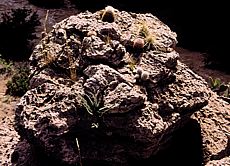Small cacti and other succulent plants can be grown in holes in tufa or limestone blocks. This mimics the situation often seen in their habitat, where well-developed cacti grow in small cracks and hollows in rock faces. Choose small plants native to limestone areas, which may often be bought as seedlings. Many white-spined Escobarias and Mammillarias remain small when mature and are very suitable.
Avoid lime-intolerant plants e.g. Echeverias, possibly Gymnocalyciums and cacti that grow large when mature.
Carefully enlarge natural holes in the block of tufa with a masonry drill to provide sufficient root space. Wash peat-based compost from the roots. Insert the roots into holes in the tufa, filling around with loam mixed with 10% dolomite of lime. Small pieces of limestone may be used to cover the hole and wedge the plant in place.
As there is less root space than in normal cultivation, the plants will need watering more often than is usual for pot-grown plants. The block of tufa may be stood on the patio during the summer to catch the rain. Indoors, or during dry periods, a little water allowed to run over the limestone will find its way into the planting holes. Feed with low-nitrogen cactus fertiliser to maintain compact growth.

 |
Upper left: block of porous limestone similar to tufa planted with:
Escobaria vivipara (left),
Echinocereus viridiflora (top center),
Epithelantha micromeris var. ungispina (lower center)
Escobaria tuberculosa (right).
Lower left: A natural example of cacti growing on a heavily eroded block of limestone, near Dog Canyon in the Big Bend National Park, Texas. Several species of lime-tolerant cacti probably include:
Escobaria tuberculosa
Echinocereus dasyacanthus
Echinocereus stramineus
and accompanied by a xerophytic fern and tufts of grass.
|


 The Cultivation Page
The Cultivation Page 














